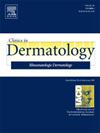Childhood and adolescent melanoma: An update
IF 2.3
4区 医学
Q2 DERMATOLOGY
引用次数: 0
Abstract
Pediatric melanoma is a rare but clinically significant public health concern, as it accounts for 7% of all malignancies in adolescents aged 15 to 19. Given the overall rarity of pediatric melanoma, especially in preadolescents, patients can go undetected, leading to a delay in treatment. We divide pediatric melanoma subtypes into three distinct age ranges—infantile, preadolescent, and adolescent—and distinguish the clinical features, prognosis, and associated risk factors of each age range. We next summarize the three predominant melanoma subtypes—Spitzoid melanoma, congenital melanocytic nevus-associated melanoma, and conventional (adult-type) melanoma—and provide distinguishing clinical, histologic, and genetic features from their difficult-to-differentiate benign counterparts. We conclude by reviewing consensus guidelines for pediatric melanoma staging and treatment, with a special emphasis on outlining barriers to adapting the advancements in targeted therapeutics into the standard care of pediatric melanoma.
求助全文
约1分钟内获得全文
求助全文
来源期刊

Clinics in dermatology
医学-皮肤病学
CiteScore
4.60
自引率
7.40%
发文量
106
审稿时长
3 days
期刊介绍:
Clinics in Dermatology brings you the most practical and comprehensive information on the treatment and care of skin disorders. Each issue features a Guest Editor and is devoted to a single timely topic relating to clinical dermatology.
Clinics in Dermatology provides information that is...
• Clinically oriented -- from evaluation to treatment, Clinics in Dermatology covers what is most relevant to you in your practice.
• Authoritative -- world-renowned experts in the field assure the high-quality and currency of each issue by reporting on their areas of expertise.
• Well-illustrated -- each issue is complete with photos, drawings and diagrams to illustrate points and demonstrate techniques.
 求助内容:
求助内容: 应助结果提醒方式:
应助结果提醒方式:


